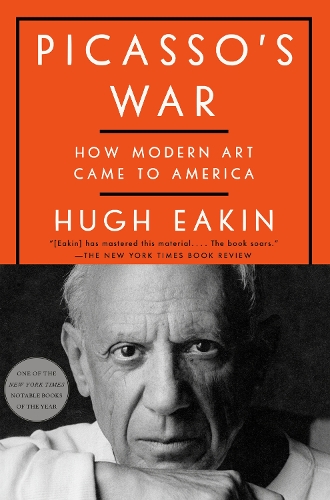
Picasso's War: How Modern Art Came to America
(Hardback)
Available Formats
Publishing Details
Picasso's War: How Modern Art Came to America
By (Author) Hugh Eakin
Random House USA Inc
Crown Publications
12th July 2022
United States
Classifications
General
Non Fiction
709.2
Physical Properties
Hardback
480
Width 163mm, Height 241mm
Description
A riveting story of how dueling ambitions and the power of prodigy made America the cultural center of the world-and Picasso the most famous artist alive-in the shadow of World War II " Eakin has mastered this material. . . . The book soars."-The New York Times Book Review (Editors' Choice) ONE OF THE BEST BOOKS OF THE YEAR- Vanity Fair, The New York Times Book Review, The New Yorker In January 1939, Pablo Picasso was renowned in Europe but disdained by many in the United States. One year later, Americans across the country were clamoring to see his art. How did the controversial leader of the Paris avant-garde break through to the heart of American culture The answer begins a generation earlier, when a renegade Irish American lawyer named John Quinn set out to build the greatest collection of Picassos in existence. His dream of a museum to house them died with him, until it was rediscovered by Alfred H. Barr, Jr., a cultural visionary who, at the age of twenty-seven, became the director of New York's new Museum of Modern Art. Barr and Quinn's shared goal would be thwarted in the years to come-by popular hostility, by the Depression, by Parisian intrigues, and by Picasso himself. It would take Hitler's campaign against Jews and modern art, and Barr's fraught alliance with Paul Rosenberg, Picasso's persecuted dealer, to get Picasso's most important paintings out of Europe. Mounted in the shadow of war, the groundbreaking exhibition Picasso- Forty Years of His Art would launch Picasso in America, define MoMA as we know it, and shift the focus of the art world from Paris to New York. Picasso's War is the never-before-told story about how a single exhibition, a decade in the making, irrevocably changed American taste, and in doing so saved dozens of the twentieth century's most enduring artworks from the Nazis. Through a deft combination of new scholarship and vivid storytelling, Hugh Eakin shows how two men and their obsession with Picasso changed the art world forever.
Reviews
[Eakin] has mastered this material, read a mountain of sources and synthesized them skillfully, and he manages to braid aesthetics with history with personal details. . . . The book soars. His achievement is keeping the complex plotline moving, while offering sharp insights and astute judgments.The New York Times Book Review (Editors Choice)
Eakin spins neglected yarns of art history into pure gold in this clear, sensitive, and deftly written narrative.Vanity Fair
Admirable and enjoyable . . .The story in Picassos War is well told, with an impressive level of biographical detail.The New Yorker
Rollicking and fascinating . . . The path to recognizing and canonizing great art is messy. Eakin documents this fact in fantastic fashion.Foreign Policy
An account that Eakin tells so well that, like any good novel, once you get into the story, it is hard to put the book down. He is a highly skilled writer who fully develops his characters. . . . In some instances, Eakin paints such a vivid picture of a given event that you feel as though you are in the room witnessing it.The Brooklyn Rail
This is an exciting story about a king gaining his crown. Hugh Eakin writes with natural authority but also with a novelists eye, making it new with telling detail, deft portraits, and dramatic scenes.Mark Stevens, Pulitzer Prizewinning co-author of De Kooning
Eakin is a marvelous writer. Fascinating, eloquent, wonderfully lucid, Picassos War will change whatever we thought we knew about modern art and its complicated reception on this side of the Atlantic.Francine Prose, author of The Vixen
There will always be more to say about Picasso. Eakins book throws new light on the prolonged and often fierce opposition to his workand to modern artin the United States. Eakin focuses on the tiny group of supporters, each of whom comes vividly to life on the page, who fought and eventually routed the anti-modernists.Calvin Tomkins, author of Duchamp
Eakin tells an intriguing and gripping story with clarity and finely judged pace. His portraits of the main players are astute and fascinating, as is his picture of a changing America.Colm Tibn, author of The Magician
At once a compulsive, vivid history about Americas mercurial culture and an incisive meditation on art, ambition, power, and the spoils of war, this is an important, groundbreaking book.Abbott Kahler, author of The Ghosts of Eden Park (asKaren Abbott)
A dramatic narrative and a brilliant, timely corrective of the history of Picassos reception in America, Eakins roller-coaster ride through twentieth-century art reminds us that Picassos triumph was very far from inevitable.Gijs van Hensbergen, author of Guernica
Chock full of suspense and brilliantly rendered, this will have art connoisseurs transfixed.Publishers Weekly
Author Bio
Hugh Eakin, a senior editor at Foreign Affairs, has written about museums and the art world for The New York Review of Books, Vanity Fair, The New Yorker, and The New York Times.
